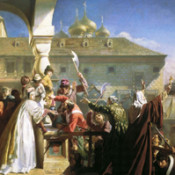
Streltsy Uprising began in Moscow
On May 15 (25) 1682 in Moscow kicked off Streltsy uprising, which brought Tsarevna Sophia Alexeevna, the daughter of Tsar Alexis of Russia (Alexei Mikhailovich Romanov) and Maria I. Miloslavskaya, to power.
Streltsy were the units of Russian guardsmen in the 16th – 18th cc. armed with firearms. The first streltsy units were created between 1540-1550. Initially they were recruited among free tradespeople and rural population. Further military service in this unit became lifelong and hereditary. The Streltsy of Moscow guarded the Kremlin, performed general guard duty, and participated in military operations.
In February 1682 the number of Moscow Streltsy reached 14,000 people. Abuse on the part of administration and commanders, military service hardships, frequent salary delays gradually lead to discontent on the part of Streltsy units.
After the death of the Tsar Feodor III of Russia (Feodor III Alexeevich of Russia) on April 27 (May 7) in 1682, two rival families — Miloslavsky and Naryshkin families — relatives of the first and second wives of Alexei Mikhailovich, concentrated their efforts in order to seize the throne. Bypassing the elder brother –16 years old Ivan Alexeevich, the tsar was proclaimed 10 years old Peter, the younger son of the Tsar Alexei Mikhailovich and Natalia Naryshkina. This fact exacerbated the crisis of the governmental power; in the struggle for the throne were involved dissatisfied Streltsy units, who supported the Miloslavsky family.
On May 15 (25), triggered by the false rumors dealing with murder of tsarevich Ivan V, Streltsy units headed by the commander of the Streltsy Department Ivan A. Khavansky, moved towards the Tsar’s Palace carrying banners and guns. On the porch they were met by the boyar Artamon S. Matveev, other boyars and Patriarch Joachim, who brought Ivan and Peter to them. Artamon Matveev and Patriarch walked down the porch and tried to persuade the crowd to leave. They practically succeeded to calm rebels down, however that very moment interfered Prince Mikhail Yu. Dolgorukiy, who threatened Streltsy and ordered them to return to their settlements. Streltsy threw him off the porch to spears and lynched him. After that the crowd of furious rebels murdered Matveev, burst into the Palace looking for and killing members of Naryshkin family. Within the following three days in Moscow rebels massacred many leaders of prikazy and prominent military commanders.
On May 23 (June 2) under the pressure from Streltsy, Zemsky Sobor was forced to proclaim according to seniority Ivan V, son of Alexei Mikhailovich and Maria Miloslavskaya, the first Tsar. The second tsar became Peter I, but in fact, tsarevna Sophia, being the underage tsars’ regent assumed all the power to rule the country. The Prince Khovansky was also determined to become a regent. However Sophia, who wanted to get rid of a serious rival, in September 1682 left Moscow for the village Vozdvizhenskoye (near the Trinity Lavra of St. Sergius). Here she informed on Ivan A. Khovansky, saying that with the help of Streltsy units he was going to exterminate the Tsar family, and announced about the collection of the people’s volunteer corps. Khavansky didn’t dare to challenge an open armed conflict and by the order of Sophia moved to Vozdvizhenskoye. On September 17 (27) 1682 he was executed. Deprived of their leader and promised to be granted pardon, Streltsy surrendered to governmental forces. The head of the Streltsy Department was appointed Feodor L. Shaklovity, one of the prominent figures during the reign of Sophia.
The regime of Sophia Alekseevna’s governance during a nominal reign of Peter I and Ivan V, established as a result of Strelets riot, lasted for 7 years, until September 1689, when the acute confrontation between grown-up Peter and Sophia the latter was ousted from power.
Lit.: Богоявленский С. К. Хованщина // Исторические записки. Т. 10. М., 1941; Буганов В. И. Московские восстания конца XVII в. М., 1969; Восстание в Москве 1682 года: сб. документов. М., 1976; Городские восстания в Московском государстве XVII века: Сб. документов. М.; Л., 1936; Карташов А. В. Стрелецкий бунт // Очерки по истории Русской Церкви. Т. 2. М., 1992; Масальский К. П. Стрельцы: Ист. роман. Ч. 1-4. М., 1861; Лавров С. А. Регентство Софьи Алексеевны: служилое общество и борьба за власть в верхах Русского государства в 1682-1689 гг. М., 1999; Ломоносов М. В. Описание стрелецких бунтов и правления царевны Софьи. [Электронный ресурс] // Восточная литература. 2001-2014. URL: http://www.vostlit.info/Texts/Dokumenty/Russ/XVIII/1740-1760/Lomonosov/IP/Tom_II/Opis_strelec_bunt/text.htm; Московская смута 1682 г. // Соловьёв С. М. История России с древнейших времён. Т. 13. М., 1997; То же [Электронный ресурс]. URL: http://militera.lib.ru/common/solovyev1/13_03.html; Хмыров М. Д. Стрельцы и первый стрелецкий бунт с раскольничьим мятежем: Ист. очерк. СПб., 1863; Черепнин Л. В. Классовая борьба 1682 г. на юге Московского государства // Исторические записки. Т. 4.М., 1938.
Based on the Presidential Library’s materials:
Аристов Н. Я. Московские смуты в правление царевны Софии Алексеевны. Варшава, 1871;

